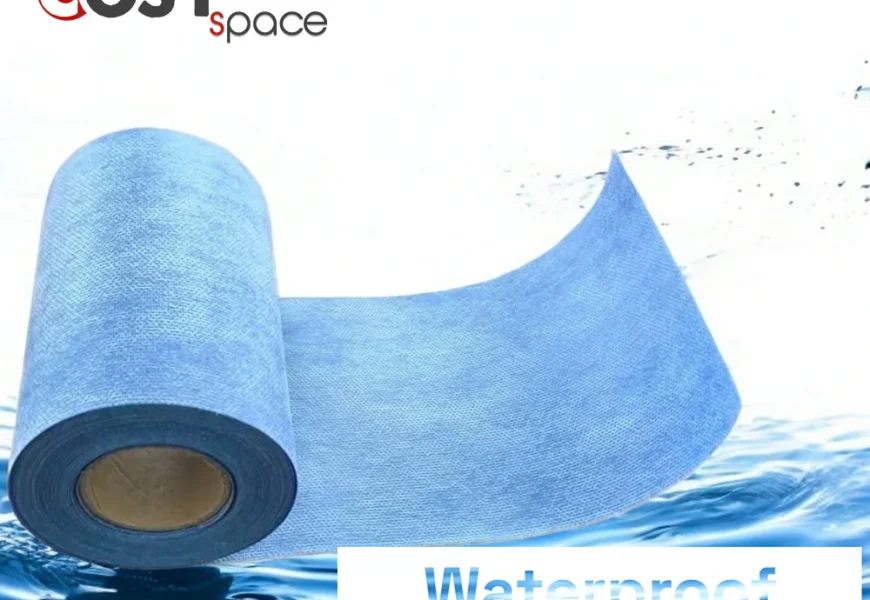Waterproof membranes are essential in modern construction, providing critical protection against water damage and preserving a building’s structural integrity. Without waterproof membranes, walls and foundations become vulnerable to moisture infiltration, leading to mold, structural weaknesses, and expensive repairs. By acting as a barrier, waterproof membranes prevent water from seeping into these key areas, reducing the risks associated with dampness and deterioration. In this guide, we’ll explore everything you need to know about waterproof membranes for walls and foundations, including the types available, key benefits, and effective application techniques. Let’s dive in!
Why Use Waterproof Membranes for Walls and Foundations?
Waterproofing solutions form a protective barrier that keeps water from penetrating walls and foundations. Foundations are particularly vulnerable to water intrusion as they are in direct contact with soil, where moisture content varies. Waterproofing not only enhances durability but also improves indoor air quality by preventing mold and mildew growth. Here’s why waterproofing applications are vital:
- Protect Against Water Damage: Membranes act as a shield, keeping moisture out.
- Increase Structure Longevity: By keeping foundations dry, membranes prevent cracks and structural weakening.
- Enhance Indoor Health: Preventing water intrusion keeps mold and mildew at bay, reducing health risks.
Types of Waterproof Membranes
There are several types of waterproofing solutions available at Cosyspace suited for different applications. Selecting the right one depends on your construction requirements, climate, and budget. Here’s a look at the main types of waterproofing products:
1. Liquid Waterproof Membranes
Liquid-applied membranes offer a seamless, flexible solution. Applied as a liquid, they form a rubbery, waterproof coating after drying. They’re often used in areas with complex shapes as they conform to any surface.
- Applications: Ideal for walls, foundations, and uneven surfaces.
- Pros: Seamless, flexible, easy to apply.
- Cons: May require more drying time and multiple coats.
2. Sheet-Based Waterproof Membranes
Sheet-based membranes come in pre-cut rolls, which are applied and sealed onto surfaces. Made from materials like bitumen, rubber, or plastic, they’re highly durable and commonly used for heavy-duty applications.
- Applications: Suitable for large walls and foundation bases.
- Pros: Highly durable, resistant to tearing, long-lasting.
- Cons: Seams require careful sealing to prevent leaks.
3. Cementitious Waterproofing
This is a cement-based waterproofing method mixed and applied to walls and foundations. It’s simple to apply and offers effective waterproofing for indoor structures and areas not exposed to direct sunlight.
- Applications: Basement walls, retaining walls, and water tanks.
- Pros: Easy to apply, cost-effective, compatible with damp surfaces.
- Cons: Not suitable for exterior exposure, may crack over time.
4. Bituminous Waterproof Membranes
Bituminous membranes are heavy-duty and often used for commercial buildings and foundations. These are sheet-based or liquid-applied and made from asphalt-based materials, known for their high resistance to moisture.
- Applications: Commercial buildings, basements, retaining walls.
- Pros: Strong water resistance, high durability.
- Cons: Typically more expensive, needs skilled installation.
How to Choose the Right Waterproof Membrane
Selecting the right waterproof membrane depends on factors like durability, exposure, and ease of application. Consider these elements when choosing a waterproof membrane for walls and foundations:
- Exposure Level: If exposed to high moisture or sunlight, choose UV-resistant or bituminous membranes.
- Installation Complexity: Sheet membranes are durable but require skilled installation, while liquid membranes are easier to apply.
- Flexibility Needs: Liquid membranes are ideal for complex surfaces, while sheet membranes are better for large, flat areas.
- Maintenance: Some membranes require regular checks, while others, like cementitious types, are low-maintenance.
Applying Waterproof Membranes: Step-by-Step Guide
Proper application is crucial for effective waterproofing. Here’s a simple step-by-step guide to applying moisture barrier on walls and foundations:
Step 1: Prepare the Surface
The surface should be clean, dry, and free from dust, oil, and any loose particles. Fill in any cracks or holes with a patching material to create a smooth surface.
Step 2: Apply Primer
For better adhesion, apply a primer compatible with the chosen waterproof membrane. Priming enhances the bond between the surface and membrane, especially on concrete walls and foundations.
Step 3: Apply the Waterproof Membrane
- For Liquid Membranes: Use a brush, roller, or spray to apply the first coat evenly. Allow it to dry, then apply additional coats as needed.
- For Sheet Membranes: Roll out the membrane on the surface, ensuring a 2-3 inch overlap between sheets. Use a heat gun or adhesive to secure seams.
Step 4: Seal the Edges and Corners
Corners and edges are more prone to water penetration. Apply extra layers or specialized corner seals for added protection.
Step 5: Inspect the Membrane
After application, inspect the surface for gaps or bubbles. Ensure the membrane covers the surface completely without any unsealed areas.
Benefits of Waterproof Membranes for Walls and Foundations
Moisture barriers offer several advantages beyond just keeping water out. Here’s how they benefit structures:
- Longer Structure Life: Keeps walls and foundations dry, preventing weakening or cracking.
- Energy Efficiency: Prevents drafts and temperature shifts, making buildings more energy-efficient.
- Reduces Repair Costs: Avoids costly water damage repairs, saving you money in the long run.
- Environmentally Friendly: Certain types of membranes, like eco-friendly liquid membranes, offer sustainable options for green buildings.
Waterproof Membrane Installation Tips
To maximize the effectiveness of moisture barrier, keep these tips in mind:
- Ensure Surface Readiness: A clean, dry surface is essential for proper adhesion.
- Apply in Optimal Weather: Avoid application during rainy or humid conditions, especially with liquid membranes.
- Use Multiple Layers if Needed: For high-moisture areas, use multiple coats for added protection.
- Seal All Edges: Carefully seal seams, edges, and corners to avoid leaks.
- Inspect Regularly: Over time, inspect membranes for wear and tear, especially in exposed areas.
Comparing Waterproof Membranes: Liquid vs. Sheet-Based
Each type of waterproof membrane has unique benefits and limitations. Here’s a quick comparison to help you decide:
| Feature | Liquid Membrane | Sheet-Based Membrane |
| Application Ease | Simple, conformable to any shape | Requires precision for large areas |
| Durability | Flexible but may need recoating | Highly durable, long-lasting |
| Cost | Generally affordable | Can be more expensive |
| Best Use | Small, complex surfaces | Large, flat surfaces |
Common Issues with Waterproof Membranes
While waterproofing technologies are highly effective, certain issues can arise, especially with improper application. Here’s a look at common problems:
- Blistering: Air trapped between layers can cause bubbles. Avoid this by applying membranes on dry, even surfaces.
- Peeling: Poor adhesion can cause membranes to peel. Proper surface preparation and priming prevent this.
- Seam Leaks: In sheet membranes, unsealed seams can lead to leaks. Heat-sealing or adhesive ensures strong bonds.
Maintenance Tips for Waterproof Membranes
Proper maintenance extends the life of waterproofing technologies and ensures they function well over time. Here are some tips:
- Inspect Regularly: Check for signs of wear, especially after extreme weather.
- Repair Damages Quickly: Address any tears or cracks to prevent further water intrusion.
- Clean Gently: Avoid using harsh chemicals on exposed membranes. Lightly scrub with water to remove dirt.
Frequently Asked Questions (FAQs)
- How long do waterproof membranes last?
Most waterproofing solutions last 10 to 15 years, but high-quality materials and proper maintenance can extend their life further. - Can I apply a waterproof membrane on an old foundation?
Yes, as long as the surface is clean and prepped, you can apply waterproofing products on older foundations. - Are waterproof membranes necessary for above-ground walls?
While essential for foundations, waterproofing is also useful for above-ground walls in areas with heavy rain or high moisture. - Do waterproof membranes require professional installation?
Not necessarily. Liquid membranes are relatively easy for DIY installation, but sheet-based membranes may need a professional touch.
Conclusion
Waterproofing products are essential for protecting walls and foundations from damaging moisture. Choosing the right waterproofing solution and applying it properly preserves your building’s structure, prevents water intrusion, and reduces maintenance costs. With effective waterproofing, you can prevent mold, mildew, and structural issues that arise from trapped moisture, helping to avoid costly repairs. Waterproofing not only protects your property but also ensures a healthier, more comfortable indoor environment. By using the knowledge from this guide, you’re now prepared to select, install, and maintain the best waterproofing products suited to your needs. Take the steps needed to reinforce your building with a strong layer of protection and give it the durability to stand up against rain, groundwater, and humidity. Start now to ensure long-lasting resilience and peace of mind for your property.










